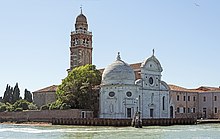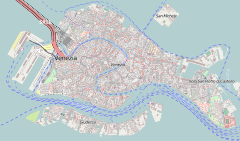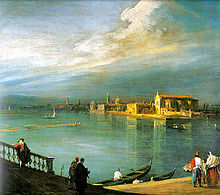| San Michele in Isola | |
|---|---|
 San Michele all'Isola in Venice San Michele all'Isola in Venice | |
| Religion | |
| Affiliation | Roman Catholic |
| Province | Venice |
| Location | |
| Location | Venice, Italy |
  | |
| Geographic coordinates | 45°26′57″N 12°20′49″E / 45.44907°N 12.34698°E / 45.44907; 12.34698 |
| Architecture | |
| Completed | 1469 |
San Michele in Isola is a Roman Catholic church, located on the Isola di San Michele, a small islet sited between Venice and Murano, which once sheltered a Camaldolese monastery (Italian: Monastero di S. Michele di Murano), but now houses the main cemetery of the city. The monastery was mostly demolished in the 19th century, but the church remains, originally rebuilt starting in 1469. The church is dedicated to Saint Michael (Roman Catholic), the holder of the scales on Judgement Day, a fit guardian of the sleep of the faithful dead. The island cemetery now includes the land of the formerly separate island of San Cristoforo. This church is sometimes referred to as San Michele di Murano, although this islet is separate from islands comprising that town.


History of the monastery
It is stated by Cornaro, that Camaldolese tradition holds that Saint Romuald, founder of the order, lived circa the year 1000 on this island, perhaps attracted by its insularity relative to the main islands of Venice. However, the first documentation we have is that a church dedicated to St Michael was granted in 1212 to the monastic order under the assent of the Bishops Marco Niccola and Buono Balbi. The church was consecrated in 1221 with attendance of Doge Pietro Ziani.
The abbey at the site endured some tumults during the following centuries, most regarding dissents within the Camaldolese; however, it remained a major institution in Venice. The Camaldolese theologian Angelo Calogera resided in this monastery in 1716–1724. The monk and cartographer, Fra Mauro, known for his map of the world dating to 1450, was associated with the monastery. Placido Zurla, also a monk at San Michele, wrote an account of the map, titled Il Mappamondo di Fra Mauro. At San Michele, Placido was to befriend the fellow Camaldolese, Mauro Cappellari, who later became Pope Gregory XVI. Others associated with the monastery include Pietro I Orseolo, Anselmo Costadoni, Gian Benedetto Mittarelli, and Pietro Delfino.
In 1810 the monastery was suppressed by the Napoleonic armies during his occupation of the Veneto. The monks continued their communal existence as the faculty of a college, till that too was dissolved in 1814. The community then transferred to Padua. At that point, many of the remaining monastic buildings were demolished, and the land began being used as a cemetery. Among those buried in this cemetery are Ezra Pound and Igor Stravinsky. The church was managed for a time by an order of Padri Reformati.
Church of San Michele
In 1453, a fire destroyed the old church, prompting reconstruction by Mauro Codussi as the architect, completed in 1469. This is the first church known to have been designed by Codussi. Built entirely in salt-white Istrian stone, the facade has weathered to a pale gray. San Michele is considered one of the first examples of Renaissance architecture in Venice, with a facade that appears influenced by the work of Alberti. The strongly delineated masonry courses of the ashlar facade are carried right across the Ionic pilasters, a strikingly unusual feature for which that R. Lieberman could only find an earlier parallel in Bernardo Rossellino's Palazzo Piccolomini in Pienza, also of the 1460s, and also produced in an Albertian milieu. The design was influential in Venice. When it was finished, a monk of the community wrote, "The facade, now complete and perfect, shiner of such a beauty so that it turns in itself the light of the eyes of all those who walk or sail by".
The interior has a nave and two aisles, with polychrome marble decorations. A description from 1868 recalls the decoration of the church included a Bust of Cardinal Giovanni Dolfin (1622), sculpted by Bernini, and located above the interior portal. The organ doors had four paintings by Domenico Campagnola. In the nave were paintings of St Boniface and a Russian Ruler by Gregorio Lazzarini, and painting depicting the Blessed Michele Pini by Ambrogio Bono. The tomb of Paolo Sarpi had been moved here from the church of the Servi. The main chapel, had a Moses and the serpent by Antonio Zanchi, and an Adoration of the Golden Calf by Lazzarini. The Cappella Emiliana, commissioned by Giovanni Miani for his wife Margherita Vitturi, was completed in 1530 by Guglielmo Bergamesco.

Next to the main façade is the Cappella Emiliani (1530). On the other side is a cloister dating to the 15th century, through which the cemetery can be reached.
See also
Notes
- Notizie storiche delle chiese e monasteri di Venezia, e di Torcello, by Flaminio Cornaro; Stamperia del Seminario Appresso Giovanni Manfre, Padua (1758); page 638.
- F Cornaro, page 638-642.
- Nuova enciclopedia popolare italiana, Volume 4, page 149.
- Guida fedele del forestiero per la città di Venezia, 4th edition; Giovanni Brizeghel, Tipografia Litografica Calc Librajo, Venice (1868); page 218.
- See Isola di San Michele for a longer list.
- F Cornaro, page 642-643.
- R. Lieberman, reviewing L. and L.O. Puppi, Mauro Codussi e l'architettura veneziana (1977) in Journal of the Society of Architectural Historians, 38.4 (December 1979:387-390) p. 388.
- Noted by Lieberman and others, comparing it to the Tempio Malatestiano in Rimini.
- They are not quite channeled rustication.
- Quoted, from Puppi and Puppi 1997, by Marco Frascari, "The Lume Materiale in the Architecture of Venice", Perspecta 24 (1988:137-145) p. 138f; Frascari is discussing the "material light" of Istrian stone in Venice. The quote is more easily followed if one understands the classical concept of vision in the form of eye-beams that darted from the eye to the object seen, resulting in the refractory qualities of this light-reflecting stone.
- Venice : Her Art-treasures and Historical Associations: A Guide to the City by Adalbert Muller, 1864, pages 315-316.
External links
- [REDACTED] Media related to San Michele in Isola at Wikimedia Commons